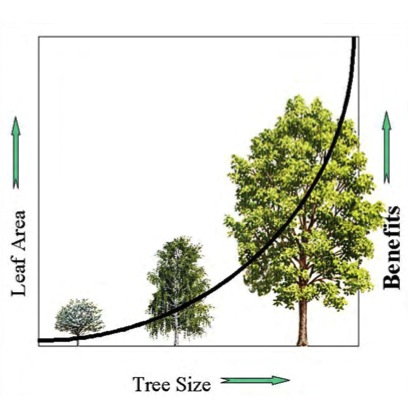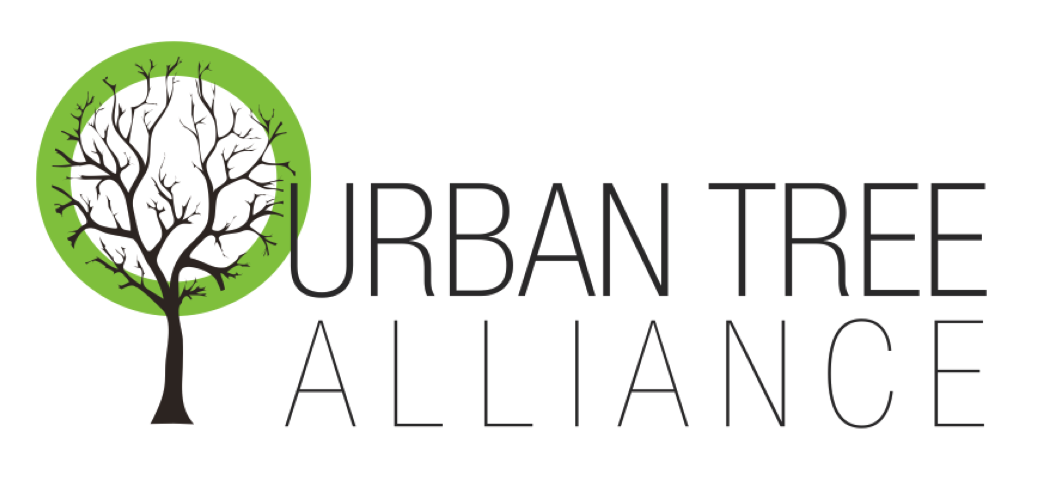Urban forests provide a multitude of benefits that make city-dwelling enjoyable. They remove air pollutants, lessen home heating and cooling costs, reduce the urban heat-island effect, absorb noise, capture stormwater, sequester carbon, increase property values, and provide cultural and aesthetic value. Below you’ll find a summary each of these services.
Large trees provide exponentially greater services to their community. This is why the Urban Tree Alliance stresses the importance of caring for aging trees.
To calculate the benefits of the trees on your property visit The National Tree Benefit Calculator.

Air Pollution Removal
Trees filter-out air pollutants at amazing rates. They remove many common air pollutants including: nitrogen dioxide, sulfur dioxide, ozone, carbon monoxide, and particulate pollutants. Air pollutants are linked to dramatic increases in asthma rates among children, prompting cities such as New York to target areas of high asthma rates for tree plantings. By preserving and growing the trees in our communities we are provided with cleaner air to breath.
Heating and Cooling Costs
Strategically planted trees can shade a home or business from the hot summer sun and slow the chilling winter winds. These benefits result in lower utility bills and reduced pressure on power plants. When planting a tree it is wise to consider the location of the tree relative to the sun’s trajectory in winter and summer to maximize solar interception in the summer and passive solar gains in the winter.
Urban Heat Island Effect
Urban areas typically experience temperatures 5-10 degrees above their rural surroundings. Trees can dramatically reduce this by shading concrete, asphalt, and brick surfaces that typically absorb and radiate solar heat. They also cool their surroundings through the process of evapotranspiration (the release of water from leaves).
By reducing ambient urban temperatures we reduce the cost of cooling buildings and provide a more healthy and comfortable environment for city residents.
Stormwater Capture
Trees help to reduce the amount of stormwater that runs off into our streams and lakes. Leaves, branches, and bark capture rainwater before it hits the surface and roots help water absorb into the soil rather than running off. By reducing runoff over impervious surfaces like roads, driveways, parking lots, and roofs fewer pollutants are carried off of these areas by stormwater and therefore do not end up in the lakes and streams we value in Southern Wisconsin.
The volume of water intercepted by trees is significant. For example, according to the US Forest Service’s Tree Benefit Calculator, a medium size maple tree (16″ Sugar Maple) intercepts 1550 gallons of stormwater per year. Across a large urban area this becomes very valuable. The Washington D.C. metropolitan area found that their trees reduce the need for stormwater infrastructure by 949 million cubic feet annually–a savings of $4.7 billion over a 20-year construction cycle.
Property Value Increase
The visual appeal of trees has been found to increase the value of homes, rental properties, and shopping districts throughout the country. Several studies have shown that homes with trees sell for 3.5-7% higher than similar homes without trees. One survey of real estate agents found that 85% thought a home with trees would be up to 20% more salable than a comprable property without trees. Even rental properties have been found to benefit from trees. A study in Portland, WA found significantly higher rental prices for properties with trees. People not only like to live near trees, they also like to shop amongst them: a study showed that consumers are willing to pay an average of 12% more for goods and services at stores with tree-lined landscapes.
Not only do trees look appealing, they are probably one of the most effective investments you can make in your home, rental, or commercial property.
